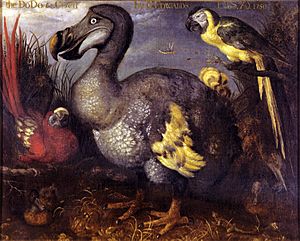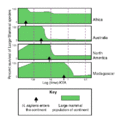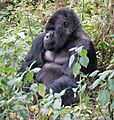Holocene extinction facts for kids

The Holocene extinction is a big event happening right now where many species of plants and animals are disappearing forever. It's like a huge wave of extinction that started after the last ice age, and it's mostly caused by humans.
Many large mammals disappeared after the ice age because of hunting by early humans and changes in the climate. Today, the main reasons animals and plants are vanishing are habitat destruction (when their homes are ruined) and over-harvesting (when too many are taken). This problem has grown much bigger because the human population has increased a lot since the time people started farming.
Natural habitats, like forests, have shrunk around the world. This loss of living space is a major reason why so many species are becoming extinct.
Contents
What is the Holocene Extinction?
The Holocene extinction is the ongoing loss of species during the Holocene period, which is the current geological time. Scientists believe it started around 11,700 years ago, after the last ice age ended. Unlike past extinctions caused by natural events like asteroids, this one is mainly driven by human activities.
Why are Animals Disappearing?
Many things cause species to disappear, but humans play a big role in the current extinction event. Here are the main reasons:
Losing Their Homes: Habitat Destruction
When humans build cities, farms, or cut down forests, they destroy the natural homes of animals and plants. This is called habitat destruction. Without a safe place to live, find food, and raise their young, species cannot survive. For example, many animals lose their homes when rainforests are cleared for farming.
Taking Too Much: Over-harvesting
Over-harvesting means taking too many animals or plants from the wild. This can happen through hunting, fishing, or collecting plants. If people take more than can be replaced by natural reproduction, the population of that species will shrink and eventually disappear. For instance, some fish species are in danger because of too much fishing.
A Changing World: Climate Change
The Earth's climate is changing, largely because of human activities like burning fossil fuels. This climate change can make habitats too hot, too cold, too wet, or too dry for certain species to survive. For example, polar bears are struggling because their icy homes are melting. The Bramble Cay melomys, a small rodent, was declared extinct in 2016, and it's believed to be the first mammal extinction directly caused by human-made climate change.
New Neighbors: Invasive Species
Sometimes, humans accidentally or purposefully introduce new species into an area where they don't naturally belong. These "invasive species" can outcompete native species for food and space, or even hunt them. This can lead to the decline or extinction of the native animals and plants.
Pollution: A Dirty Problem
Pollution from factories, farms, and cities can harm animals and plants. Water pollution, air pollution, and even plastic waste can make environments toxic and unhealthy. This can weaken species, make them sick, or even kill them directly.
Animals in Danger Today
Many well-known animals are currently facing extinction. For example, the mountain gorilla is critically endangered, with only about 880 left. Over 60% of all primate species are at risk of extinction, and 75% have shrinking populations. The last male northern white rhinoceros, named Sudan, died in 2018, leaving only two females of his subspecies. The golden toad of Costa Rica, a beautiful amphibian, disappeared around 1989 due to a mix of climate warming, fungus, and habitat loss.
Images for kids
-
A diagram showing the ecological processes of coral reefs before and during the Anthropocene
-
The percentage of megafauna on different land masses over time, with the arrival of humans indicated.
-
Top: Arid ice age climate Middle: Atlantic Period, warm and wet Bottom: Potential vegetation in climate now if not for human effects like agriculture.
-
There are roughly 880 mountain gorillas remaining. 60% of primate species face an anthropogenically driven extinction crisis and 75% have declining populations.
-
Angalifu, a male northern white rhinoceros at the San Diego Zoo Safari Park (died December 2014). Sudan, the last male of the subspecies died on March 19, 2018.
-
Bramble Cay melomys were declared extinct in June 2016. This is the first recorded mammalian extinction due to anthropogenic climate change.
-
The golden toad of Costa Rica, extinct since around 1989. Its disappearance has been attributed to a confluence of several factors, including El Niño warming, fungus, habitat loss and the introduction of invasive species.
-
Reconstructed woolly mammoth bone hut, based on finds in Mezhyrich.
-
Genyornis newtoni, a 2-metre (7 ft) tall flightless bird. Evidence of egg cooking in this species is the first evidence of megafaunal hunting by humans in Australia.
-
Recently extinct flightless birds include Madagascar's elephant bird (left), Mauritius's dodo and the great auk of the Atlantic (bottom right).
See also
 In Spanish: Extinción masiva del Holoceno para niños
In Spanish: Extinción masiva del Holoceno para niños












